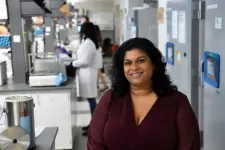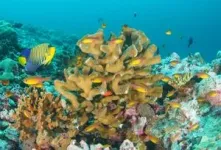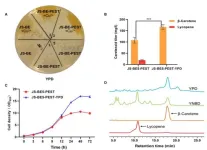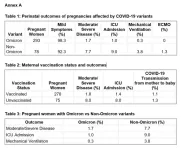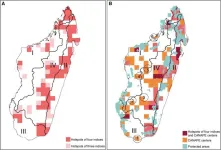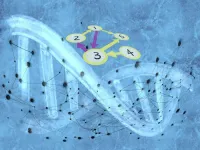(Press-News.org) *EMBARGOED UNTIL TUESDAY, MARCH 12, AT 6 A.M. ET
Age-related changes that cause the skin to stiffen and become less elastic may also contribute to higher rates of metastatic skin cancer in older people, according to research by investigators from the Johns Hopkins Kimmel Cancer Center.
The study, published March 12 in Nature Aging, shows that increased stiffness in aging skin increases the release of a protein called ICAM1. Increased ICAM1 levels stimulate blood vessel growth in the tumor, helping it grow. It also makes the blood vessels “leaky,” enabling tumor cells to escape and spread throughout the body more easily.
“As we age, the stiffness of our skin changes,” explains Ashani Weeraratna, Ph.D., associate director for laboratory research at the Kimmel Cancer Center and professor of oncology at the Johns Hopkins University School of Medicine. “That not only has physical implications, but it also has signaling implications and can lead to increases in new blood vessel growth or disruption of blood vessel function.”
Melanoma is the deadliest form of skin cancer, according to the Melanoma Research Foundation. In 2024, over 200,000 Americans are expected to be diagnosed with melanoma. Older patients are more likely to get melanoma and die from it than younger patients. They experience more recurrences after treatment, and their tumors are more likely to spread, or metastasize, to other parts of the body.
Weeraratna’s laboratory focuses on how age-related changes help melanoma tumors spread and resist cancer therapies. Previous research by Weeraratna and her team has shown that a protein called HAPLN1 helps maintain the structure of the extracellular matrix, a network of molecules and minerals that provide structural support, to keep the skin supple. As people age, they release less HAPLN1, which causes the skin to stiffen.
The new study shows that reduced HAPLN1 indirectly increases ICAM1 levels by causing stiffening, which alters cellular signaling. The increase in ICAM1 contributes to angiogenesis, or the growth of new blood vessels that supply the tumors with nutrients and help them grow. The blood vessels are also leakier, making it easier for tumor cells to escape from the initial tumor site and spread to distant areas of the body.
Treating older mice with melanoma with drugs that block ICAM1, however, prevents these changes, shrinking their tumors and reducing metastasis, Weeraratna and her colleagues demonstrated. They are now studying ICAM1’s activities to develop more precise ways of targeting it with drugs, which might lead to new approaches to treating older people with melanoma.
The discoveries might also lead to new approaches to treating other age-related cancers. Previous therapies targeting growth factors that contribute to angiogenesis have failed in many tumor types, including melanoma. But ICAM1 provides a promising new target.
“We know that age-related angiogenesis is important in many different cancers and multiple aspects of health and disease,” says Weeraratna, who is also the E.V. McCollum Chair of Biochemistry and Molecular Biology at the Johns Hopkins Bloomberg School of Public Health and a Bloomberg Distinguished Professor. “Finding a new way to target that in different tumor types could have a big impact.”
Learning more about ICAM could also have important implications for understanding wound healing in older adults. Angiogenesis is essential in healing wounds not only in the skin, but also in the cardiovascular system and brain, Weeraratna says. As a result, the lab’s discoveries could have important implications for understanding age-related changes that may contribute to cardiovascular disease or strokes.
“Understanding angiogenesis in the context of aging is important,” she says.
Study co-authors were Gloria E. Marino-Bravante, Alexis E. Carey, Laura Hüser, Agrani Dixit, Vania Wang, Supeng Ding, Rahel Schnellmann, Luo Gu and Yash Chhabra of Johns Hopkins. Other authors were from the University of Pennsylvania and Duke University.
The study was supported in part by the National Institutes of Health (grants P01CA114046, U01CA227550 and R01CA232256 to Weeraratna).
Weeraratna is on the board of ReGAIN Therapeutics. This relationship is managed by The Johns Hopkins University in accordance with its conflict-of-interest policies.
END
Age-related changes in skin may contribute to melanoma metastases
2024-03-12
ELSE PRESS RELEASES FROM THIS DATE:
A coral superhighway in the Indian Ocean
2024-03-12
Despite being scattered across more than a million square kilometres, new research has revealed that remote coral reefs across the Seychelles are closely related. Using genetic analyses and oceanographic modelling, researchers at Oxford University demonstrated for the first time that a network of ocean currents scatter significant numbers of larvae between these distant islands, acting as a ‘coral superhighway.’ These results are published today in Scientific Reports.
Dr April Burt (Department of Biology, University of Oxford, and Seychelles Islands Foundation), lead author of the study, said: ‘This discovery is very important because a key factor ...
Scientists develop a rapid gene-editing screen to find effects of cancer mutations
2024-03-12
CAMBRIDGE, MA -- Tumors can carry mutations in hundreds of different genes, and each of those genes may be mutated in different ways — some mutations simply replace one DNA nucleotide with another, while others insert or delete larger sections of DNA.
Until now, there has been no way to quickly and easily screen each of those mutations in their natural setting to see what role they may play in the development, progression, and treatment response of a tumor. Using a variant of CRISPR genome-editing known as prime editing, MIT researchers have ...
Rainforest's next generation of trees threatened 30 years after logging
2024-03-12
Rainforest seedlings are more likely to survive in natural forests than in places where logging has happened – even if tree restoration projects have taken place, new research shows.
Scientists monitored over 5,000 seedlings for a year and a half in North Borneo.
They studied a landscape containing both natural forest and areas logged 30 years ago – some of which were recovering naturally, while some had been restored by methods including tree planting.
A drought had triggered “mast fruiting” across ...
Expertly engineered saccharomyces cerevisiae yeast strain in the optimized production of carotenoids
2024-03-12
More than 90% of the commercially available carotenoids are synthetically produced using chemicals. To meet the increasing demand for cost-effective natural compounds in carotenoid synthesis, researchers at Xiamen University, China, have developed an engineered S. cerevisiae yeast strain capable of selectively overproducing carotenoids. They redesigned the genomic sequence and critical pathways to optimize carotenoid production. This novel and successful research approach can be extended to other model ...
Beer byproduct behind Marmite could help us recycle metal waste
2024-03-12
When we recycle electronic devices we can no longer use, we expect to make the most out of the precious natural resources that went into building them. But electronic waste is notoriously difficult to recycle, because it’s hard to separate the different metals in the waste from each other. Scientists have now found a way of selectively capturing metals from a waste stream using spent brewer’s yeast, the same beer byproduct that goes into Marmite. Not only that: the yeast can be reused, making the process even more eco-friendly.
“Electronic waste is difficult to recycle because it is very heterogeneous,” said Dr Klemens Kremser ...
Guessing game: Response may bias understanding of future scenarios
2024-03-12
Does previous experience bias a person in future estimations? Yes, Osaka Metropolitan University researchers in Japan report, but only if the person engages higher processing powers by responding, as opposed to simply observing.
They made their findings through experiments involving participants estimating the number of dots flashed on a screen. Participants either had to input their estimate before making another estimate on a new set of dots or were not prompted to do anything but observe. The researchers found ...
KKH-led study reveals low COVID-19 transmission rate from mothers to newborns
2024-03-12
11 March 2024, Singapore – A study[1] by KK Women’s and Children’s Hospital (KKH), Singapore General Hospital (SGH) and National University Hospital (NUH) has revealed that COVID-19 transmission from mothers to their newborns is low.
The study involving 371 women who had COVID-19 infection during pregnancy and their newborns found that only four infants or 1.1 per cent of the babies were diagnosed with COVID-19 after birth, of which three (1.1 per cent) were from mothers who were COVID-19 vaccinated and one infant (1.3 per cent) was from a mother who was not vaccinated.
Senior Author of the study, Dr Yeo Kee Thai, Senior Consultant, Department of Neonatology, KKH ...
Scientists identify biodiversity conservation gaps in Madagascar
2024-03-12
Despite the importance of biodiversity and the urgency to conserve it, assessing what aspect of biodiversity requires the highest priority has proven complex, especially when conservation resources are limited. A new study published in Current Biology sheds light on this question.
Prof. CHEN Zhiduan's team from the Institute of Botany of the Chinese Academy of Sciences (IBCAS) and international collaborators have identified the spatial heterogeneity of biodiversity hotspots and endemism centers. With ...
Sting operation out of gas
2024-03-12
Kyoto, Japan -- Cells possess an innate immune system that defends against invasive pathogens such as bacteria and viruses. Previous studies have mapped out the cytoplasmic cGAS-STING pathway in the cytoplasm, known for responding to foreign nucleic acids, such as double-stranded DNA.
Micronuclei -- or MN, abnormal intracellular structures containing the cell's DNA -- have also been suspected of triggering the pathway. However, no conclusive evidence exists of pathway activation by MN-induced cyclic GMP-AMP synthase, or cGAS.
Now, Kyoto University and the AIRC Institute of Molecular Oncology, or IFOM, have ...
Have metalenses expanded their reach into the ultraviolet region?
2024-03-12
Ultraviolet rays find diverse applications in medical and healthcare, serving purposes such as disinfection, sterilization, and therapy. They are also used in the semiconductor industry for creating microcircuits and patterns. A metalens fabrication process, developed by a team of researchers at Pohang University of Science and Technology (POSTECH), enables control over the optical properties of these UV rays. This innovation has garnered significant attention across industries, sparking interest in potential advancements.
A collaborative research team, comprising Professor Junsuk Rho from the Department of Mechanical Engineering and the Department of Chemical Engineering ...
